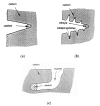Carbon Anode in Carbon History
- PMID: 33126632
- PMCID: PMC7662887
- DOI: 10.3390/molecules25214996
Carbon Anode in Carbon History
Abstract
This study examines how the several major industries, associated with a carbon artifact production, essentially belong to one, closely knit family. The common parents are the geological fossils called petroleum and coal. The study also reviews the major developments in carbon nanotechnology and electrocatalysis over the last 30 years or so. In this context, the development of various carbon materials with size, dopants, shape, and structure designed to achieve high catalytic electroactivity is reported, and among them recent carbon electrodes with many important features are presented together with their relevant applications in chemical technology, neurochemical monitoring, electrode kinetics, direct carbon fuel cells, lithium ion batteries, electrochemical capacitors, and supercapattery.
Keywords: carbon fuel cells; carbon materials; catalysis; electrochemical capacitors; lithium ion batteries; neurochemical monitoring.
Conflict of interest statement
The author declares no conflict of interest.
Figures














References
-
- Brodd R.J. Electrochemistry in Industry: New Directions. Plenum Press; New York, NY, USA: 1980.
-
- Thonstad J., Fellner P., Haarberg G.M., Hives J., Kvande H., Sterten A. Aluminium Electrolysis. Aluminium-Verlag; Dusseldorf, Germany: 2001.
-
- Grjotheim K., Welch B.J. Aluminium Smelter Technology–A Pure and Applied Approach. 2nd ed. Aluminium Verlag; Dusseldorf, Germany: 1988.
-
- Grjotheim K., Kvande H., editors. Introduction to Aluminium Electrolysis. Aluminium-Verlag; Dusseldorf, Germany: 1993.
-
- Radenović A. Svojstva komponenti ugljične anode za proizvodnju aluminija. Nafta. 2012;63:111–114.
Publication types
MeSH terms
Substances
LinkOut - more resources
Full Text Sources

